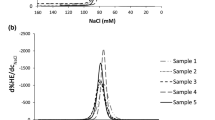Abstract
Using correlation and factor analyses, the following parameters were studied in males and females: correlations between the white blood cell (WBC) count; mean neutrophil, lymphocyte, and monocyte volume; volume variation; asymmetry coefficients; and volume distribution excess in populations of WBCs. A clear interrelationship between the quantity and the volume, i.e., the quality, was shown. The cosubordination relationship involves all studied classes of WBCs appearing as a parameter correlation within the distinct classes as well as between different classes. This phenomenon is strongly sex-specific. The relative quantity or cell volume is changed together with the concerted behavior of other WBC classes, i.e., content, volume, and distribution of the cells. It is suggested that such functional alterations are compensatory in nature and facilitate optimization of the capillary blood flow.
Similar content being viewed by others
REFERENCES
Kozinets, G.I. and Makarov, V.A., Issledovanie sistemy krovi v klinicheskoi praktike (Hematological Investigations in Clinical Practice), Moscow, 1997.
Zolotnitskaya R.P., Methods of Hematological Investigations, in Laboratornye metody issledovaniya v klinike (Laboratory Methods of Study in Clinical Practice), Moscow: Meditsina, 1987, p. 122.
Mchedlishvili, G.I., Impairment in Normal Structuring of the Blood Flow in the Microvessels as a Result of Hemorheological Disturbances, Fiziol. Zh. im. I.M. Sechenova, 1996, no. 12, p. 41.
Shumilova, T.E., Effect of White Blood Cells on the Blood Flow Dynamics in Microvessels of the Rat Brain, Fiziol. Zh. im. I. M. Sechenova, 1990, no. 4, p. 459.
Redchitz, E.G. and Parfenov, A.S., Rheological Properties of White Blood Cells and Their Role in Blood Microcirculation, Gematol. Transfuziol., 1989, no. 1, p. 40.
Redchits, E.G., The Role of Granulocytes in The Pathogenesis of Ischemic Heart Disease, Kardiologiya, 1990, no. 7, p. 115.
Todorov I., Klinicheskie laboratornye issledovaniya v pediatrii (Clinical Laboratory Investigations in Pediatrics), Sofia: Meditsina i Fizkul'tura, 1963.
Mayanskii, A.N. and Mayanskii, D.N., Ocherki o neitro-file i makrofage (Essays on Neutrophil and Macrophage), Novosibirsk: Nauka, 1989.
Kliorin, A.I. and Tiunov, L.A., Funktsional' naya neravnoznachnost' eritrotsitov (Functional Heterogeneity of Erythrocytes), Leningrad: Nauka, 1974.
La Salle, P., Alterations by Leukocytes of Erythrocyte Flow in Microchannels, Blood Cells, 1986, vol. 12, p. 179.
Author information
Authors and Affiliations
Rights and permissions
About this article
Cite this article
Matyushichev, V.B., Shamratova, V.G. & Muzafarova, D.A. Correlation between the Quantity of White Blood Cells and Their Volume Distribution Parameters in Humans. Human Physiology 27, 110–114 (2001). https://doi.org/10.1023/A:1007123811532
Issue Date:
DOI: https://doi.org/10.1023/A:1007123811532




